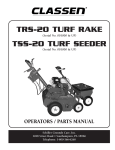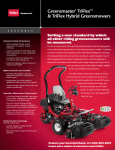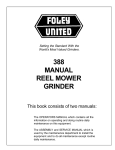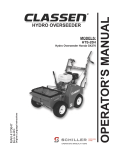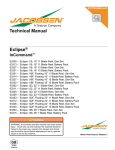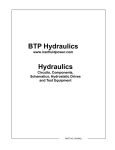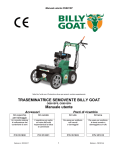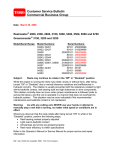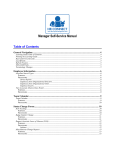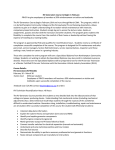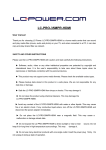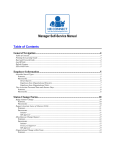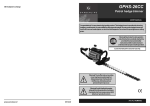Download A Guide To Evaluating Reel Mower Performance And Using The
Transcript
A Guide To Evaluating Reel Mower Performance And Using The TurfEvaluator To receive additional information on the TurfEvaluator™ contact: The Toro Company Commercial Marketing Services Department 8111 Lyndale Avenue South Bloomington, MN 55420-1196 or locate Toro on the Internet at www.toro.com Form No. 97-931-SL ©1997 — The Toro Company. All Rights Reserved. ™ ™ Printed in U.S.A. TIRE TRACK CAUSE • Tire rolling on grass • Tire pressure has an effect • Inconsistent turf density and texture EFFECT • Appearance - darker color behind tires • Playability - ball roll distance and accuracy are not normally affected if overall cut is acceptable CLIP MARK CAUSE • Incorrect clip spacing for height-of-cut • Reel speed too slow or fast for ground speed • Reel diameter or number of blades not matched to conditions • Inconsistent turf density and texture EFFECT For over 60 years, The Toro Company has been a leader in researching and developing reel mowers for low-cut, groomed turf areas. Consequently, we know that the demands on such turf are ever increasing. Users expect maximum function (playability) and aesthetic appeal. This booklet offers general guidelines for evaluating reel mower performance so that turf managers can better meet their desired goals. BOBBING CAUSE • Grass collecting on rollers • Out of round rollers • Inconsistent turf density and texture • Too fast ground speed EFFECT • Location - could be all cutting units • Appearance - wavy surface; color variations • Playability - affects ball roll distance and accuracy More than ever, turf managers must thoroughly understand reel mowers and their unique requirements. This booklet can be a helpful resource in doing so. 13 EVALUATING This booklet first reviews the basics of healthy turf and reel mowers. The latter part of this booklet is a users’ guide for the TurfEvaluator™ grass viewing tool. For more than three decades, Toro engineers have used this type of device to evaluate reel mower performance. The TurfEvaluator™ enables turf managers to compare effective heights of cut and reveal turf imperfections. • Location - could be all cutting units • Appearance - clip marks in turf • Playability - if severe, affects ball roll distance and accuracy ANGLED RIDGE INDEX CAUSE • Inaccurate height-of-cut at one end • Rollers not parallel • Uneven turf • Worn roller bearings REQUIREMENTS FOR HEALTHY TURF 2 UNDERSTANDING REEL MOWERS 2 EFFECT • Location - overlap area between cutting units • Appearance - ridge in turf with color variations • Playability - affects ball roll distance and accuracy Cutting Unit Configuration 3 SCALPING Cutting Unit Set-Up And Adjustment 4 CAUSE Height-Of-Cut 4 • Cutting below normal maintained height-of-cut • Inconsistent turf density and texture • Improper attitude for height-of-cut EFFECT • Location - within one cutting unit • Appearance - color variations • Turf appears shaved in certain areas • Playability - affects ball roll distance and accuracy GRAIN CAUSE • Inconsistent turf density and texture • Not alternating mowing directions consistently • Not using preparation devices (combs, brushes, etc.) OPTIMIZING REEL MOWER PERFORMANCE 6 Training Operators And Mechanics 6 Maintenance Checks And Adjustments 7 EVALUATING REEL MOWER PERFORMANCE Using The TurfEvaluator™ Detectable After-Cut Imperfections 8 9 10 EFFECT • Location - may affect all cutting units • Appearance - color variations; not crisp cut; spongy areas • Playability - affects ball roll distance and accuracy 12 1 REQUIREMENTS FOR HEALTHY TURF It is essential to have a basic understanding of healthy turf and reel mowers before evaluating reel mower performance. A visually appealing, predictable turf surface requires many different cultural practices. These include: Irrigation Fertilizing Spraying Aeration Verticutting Seeding Rolling Top Dressing Grooming The execution of these practices in their proper rate and sequence is critical for groomed turf areas. Mowing equipment performance is the most significant contributor to an excellent formal turf surface. Keep in mind however, that mowing equipment cannot camouf lage poor execution or lack of proper cultural practices. UNDERSTANDING REEL MOWERS When properly maintained and operated, reel mowers provide superior cut quality. These mowers are typically dedicated to cutting formal turf areas such as golf course greens, tees and fairways. A reel mower consists of a rotating reel cylinder equipped with blades and a stationary bedknife. The reel blades guide grass leaves toward the bedknife where they are cut by a shearingtype action. 2 CAUSE • Grass is double cut and rolled in this area • Roller design can have an effect EFFECT • Location - overlap area between units • Appearance - color variations in overlap area • Playability - normally does not affect playability if overall cut is good STRAIGHT MISMATCH CAUSE • Inaccurate height-of-cut setting • Uneven turf • Different attitude on one unit • Thicker bedknife on one unit • Inconsistent turf density • Worn roller bearings EFFECT • Location - overlap area between cutting units • Appearance - step in turf with color variations • Playability - affects ball roll distance and accuracy ANGLED MISMATCH CAUSE • Inaccurate height-of-cut • Rollers not parallel with cutting edge • Inconsistent turf density and texture • Worn roller bearings EFFECT • Location - overlap area between cutting units • Appearance - step in turf with color variations • Playability - affects ball roll distance and accuracy 11 EVALUATING It cannot be overstated that reel-type mowers are precision tools. It is essential that they be adjusted and operated with this in mind. OVERLAP MARK CUTTING UNIT CONFIGURATION The following illustrations exaggerate after-cut imperfections that the TurfEvaluator™ can detect. Potential cause and effects are listed. The component that most affects reel mower after-cut appearance is the individual cutting unit. Its configuration is critical to the reel mower’s efficiency and performance. As shown below, each component of the cutting unit is designed to perform a specific function. STRAGGLER (FEW) They will have a minimal effect on appearance and accuracy. Turf is normally acceptable for nontournament mowing conditions. Component • Reel - Grass throw pattern and throw distance - Height-of-cut range Number of Blades - • Incorrect bedknife to reel adjustment • Dull cutting edges • Not in clip window • Not using preparation devices • Inconsistent turf texture and density • Wrong type of roller used Speed - Throw distance - Cutting efficiency - Clip spacing • Bedknife Attitude • Rifled or uneven wear on bedknife • Damaged area on bedknife from hitting an object(s) • Loose bedknife screws • Bent reel blade EFFECT • Location - within one cutting unit • Appearance - ridge of darker color • Playability - affects ball roll distance and accuracy 10 - Cutting efficiency • Bedknife Type - Usable life - Durability - Height-of-cut potential • Roller Type - Penetration into the turf; affects effective height-of-cut - Overall weight of the unit - Grass clipping build-up on rollers; affects effective height-of-cut • Roller Scrapers - Retards grass clipping build-up on rollers STREAK CAUSE Cutting efficiency Throw pattern Length of grass blades Clip spacing Overall weight of the unit Height-of-cut range (change for different heights-of-cut and turf types) EFFECT • Location - within one cutting unit • Appearance - color variations with non-crisp feel; contributes to thatch build-up and spongy turf • Playability - affects ball roll distance and accuracy UNDERSTANDING Diameter STRAGGLER (MANY) CAUSE Performance Inf luence • Preparation Devices - All assist to stand the grass and retard the Combs build up of grain, thatch and sponginess in Brushes (rotating & fixed) groomed turf Groomers Verticutters • Mowing Speed - REQUIREMENTS DETECTABLE AFTER-CUT IMPERFECTIONS Clip spacing Cut cleanliness Power requirements Stability of cutting unit 3 CUTTING UNIT SET-UP AND ADJUSTMENT USING THE TurfEvaluator™ Reel mower performance depends on proper set-up and adjustment procedures. An error of .010 of an inch, in height end-to-end, or from one cutting unit to another, is visible as a mismatch (see Page 11) on many golf course greens. Many turf discrepancies are subtle and require closer examination. In these instances, the TurfEvaluator™ grass viewing tool is helpful. It can assist turf managers in determining causes for poor reel mower performance and comparing the effective height-of-cut of one mowed surface to another. Although there are design variations in cutting units, most require the same basic procedures. A surface plate, accurate heightof-cut tools and proper instruction are essential for setting up a cutting unit. HEIGHT-OF-CUT Prior to setting up a cutting unit, the term “height-of-cut” and how it relates to performance must be understood. Bench Set Height-of-Cut In the maintenance shop, a setting is done measuring height-of-cut from a hard, level surface to the cutting edge. This height is normally chosen through experience. It factors in turf conditions, seasonal changes and playability requirements. 4 Begin by placing the tool on the turf with slight down force on both sides. While kneeling, look into the mirror in a manner that places your line of sight f lat across the mowed surface into the grid lines. This close-up view highlights effective height-of-cut, crispness of cut, or imperfections such as mismatch, stragglers and other machine marks. VIEWPOINT ONE: Close-up grid line view Note: You would normally center the TurfEvaluator™ over streak and mismatch type discrepancies. Invert the tool and slightly move your line of sight up the mirror surface and see a large, expanded view of the turf. This view reveals stragglers and crispness of cut. VIEWPOINT TWO: Large, expanded view Variations in the mowed surface are normally most visible immediately after mowing. Using the grid lines as a reference, place the TurfEvaluator™ in two locations across the cut path. This should indicate that the cut edges are at the same height at both locations. Placing the tool in adjoining cut paths should indicate the same results. 9 EVALUATING Keep in mind that two similar cutting units of the same or different manufacturers can be bench set the same but may cut at different effective heights due to a configuration difference (i.e., weight, rollers, attitude etc.) The TurfEvaluator™ provides two horizontal viewpoints at the turf’s maintained height. EVALUATING REEL MOWER PERFORMANCE Formal, low-cut turf is evaluated primarily for its visual appearance and functional performance, also called “playability.” The turf surface can be given a quick evaluation using sight and touch. After mowing, the surface should be firm with a crisp appearance and feel. This can be sensed by placing an open palm against the surface. A crisp, brush-type feel will usually indicate minimal stragglers and an efficient cut. A spongy area is evident by the momentary impression left by feet on the surface. This is the actual height the grass has been cut. Making an accurate height measurement on the turf is difficult due to many variables. A true base is simply not present. If the surface is uneven, spongy or varies in density, color variations in the turf may appear in the form of a streak. This is due to the effective height-of-cut being too low for the existing turf conditions. To correct problems, start or change a cultural practice, change cutting unit configuration or raise the bench set height-of-cut. The lower your height-of-cut, the more predictable and smooth the turf surface must be. Maintaining Height-of-Cut and Performance To accurately maintain height-of-cut and performance, routinely check the following components: •Reel Bearings: Check for play and roughness. Replace if necessary. If adjustable, adjust to “no” lash while maintaining free rotation of the reel. •Bedknife to Reel Adjustment: Before performing any set-up procedures, it is critical that the reel and knife cutting edges are straight and sharp. Lap or grind as necessary. Adjust as needed to ensure the knife and reel contact their full length with light contact and free-reel rotation. •Attitude Adjustment: If the unit has this capability, set for height-of-cut used. •Roller Parallelism: Check for loose roller bearings. Adjust or replace as necessary. First parallel the front or rear roller, which ever is not used for setting height-of-cut. This paralleling roller is set to match the reel using a surface plate-type fixture. •Height-of-Cut: Set to desired height using an accurate tool. This procedure must be done exactly the same on each cutting unit. Note: As reel cutting unit design and configuration continue to evolve, heightof-cut settings may need modifying to retain visual and playability goals. 8 5 UNDERSTANDING It is normal for the mower to leave after-cut directional light and dark color paths. These overall color paths are due to the turf being rolled down in the direction the mower is traveling. A cut path going away from you will usually be lighter in color than the path coming toward you. Smaller, individual color variations can be due to differing turf types, density variations and straight line mower marks. Effective Height-of-Cut OPTIMIZING REEL MOWER PERFORMANCE TRAINING OPERATORS AND MECHANICS Operators and mechanics play a significant role in determining quality of cut, down time, and life of mowing equipment. Make a commitment to train and familiarize staff with each product. MAINTENANCE CHECKS AND ADJUSTMENTS Toro suggests following its reel mower maintenance and adjustment recommendations. GREENSMASTER ® 3, 300, and 3000 Maintenance Schedule Minimum Recommended Maintenance Intervals: Maintenance Procedure Daily Checks Maintenance Interval & Service Every 25hrs. Check Battery Fluid Level Check Battery Cable Connections Service Air Filter Pre-Cleaner Lubricate Grease Fittings Change Engine Oil It is important that a visual check of the machine be made each day. This can identify oil leaks, low oil levels, loose or bent components and abnormal noises. Every 100hrs. Every 400hrs. A Level Service Service Air Filter Paper Element Service Spark Plug Torque Wheel Lug Nuts Check Reel Bearing Preload Adjustment B Level Service Decarbon Combustion Chamber Adjust Value and Torque Head Bolts Check Engine RPM (idle and full throttle) C Level Service Initial break in at 5 hours Initial break in at 50 hours Replace Moving Hoses Replace Safety Switches Fuel Tank — Drain/Flush Replace Fuel Filter Hydraulic Tank — Drain/Flush Replace Hydraulic Filter Adjusting Bedknife to Reel Annual Recommendations: Items listed are recommended every 2000 hours or 2 years whichever occurs first. (See Operator’s and Service Manual for specifications and procedures) Properly adjusting the bedknife to the reel is one of the most effective preventive maintenance practices for reel mowers. The amount of contact and how frequently it is checked are major factors in performance. A light contact adjustment, if maintained, will help keep cutting edges sharp on the reel and bedknife. This requires that the adjustment be checked frequently at a predetermined time interval. Dulled cutting edges cannot be corrected immediately by adjustment or overtightening. Don’t wait until the quality of cut has deteriorated to check the adjustment. CUTTING UNIT DULLING CURVE SHARP GOOD QUALITY OF CUT * * CUTTING EDGE SHARPNESS * * POOR QUALITY OF CUT NOTE: If the cutting edges on the reel blades and bedknife are not straight and sharp the results may not be acceptable. This is true even if all other set-up procedures are correct. DULL ELAPSED TIME INTERVAL * RECOMMENDED ADJUSTING SEQUENCE 6 7 OPTIMIZING Remember, that each type of mowing equipment will have specific characteristics, behavior patterns, and noise qualities. Operators should become familiar with the product and listen for any unusual changes. Concerns should be reported to the mechanic before significant problems develop. OPTIMIZING REEL MOWER PERFORMANCE TRAINING OPERATORS AND MECHANICS Operators and mechanics play a significant role in determining quality of cut, down time, and life of mowing equipment. Make a commitment to train and familiarize staff with each product. MAINTENANCE CHECKS AND ADJUSTMENTS Toro suggests following its reel mower maintenance and adjustment recommendations. GREENSMASTER ® 3, 300, and 3000 Maintenance Schedule Minimum Recommended Maintenance Intervals: Maintenance Procedure Daily Checks Maintenance Interval & Service Every 25hrs. Check Battery Fluid Level Check Battery Cable Connections Service Air Filter Pre-Cleaner Lubricate Grease Fittings Change Engine Oil It is important that a visual check of the machine be made each day. This can identify oil leaks, low oil levels, loose or bent components and abnormal noises. Every 100hrs. Every 400hrs. A Level Service Service Air Filter Paper Element Service Spark Plug Torque Wheel Lug Nuts Check Reel Bearing Preload Adjustment B Level Service Decarbon Combustion Chamber Adjust Value and Torque Head Bolts Check Engine RPM (idle and full throttle) C Level Service Initial break in at 5 hours Initial break in at 50 hours Replace Moving Hoses Replace Safety Switches Fuel Tank — Drain/Flush Replace Fuel Filter Hydraulic Tank — Drain/Flush Replace Hydraulic Filter Adjusting Bedknife to Reel Annual Recommendations: Items listed are recommended every 2000 hours or 2 years whichever occurs first. (See Operator’s and Service Manual for specifications and procedures) Properly adjusting the bedknife to the reel is one of the most effective preventive maintenance practices for reel mowers. The amount of contact and how frequently it is checked are major factors in performance. A light contact adjustment, if maintained, will help keep cutting edges sharp on the reel and bedknife. This requires that the adjustment be checked frequently at a predetermined time interval. Dulled cutting edges cannot be corrected immediately by adjustment or overtightening. Don’t wait until the quality of cut has deteriorated to check the adjustment. CUTTING UNIT DULLING CURVE SHARP GOOD QUALITY OF CUT * * CUTTING EDGE SHARPNESS * * POOR QUALITY OF CUT NOTE: If the cutting edges on the reel blades and bedknife are not straight and sharp the results may not be acceptable. This is true even if all other set-up procedures are correct. DULL ELAPSED TIME INTERVAL * RECOMMENDED ADJUSTING SEQUENCE 6 7 OPTIMIZING Remember, that each type of mowing equipment will have specific characteristics, behavior patterns, and noise qualities. Operators should become familiar with the product and listen for any unusual changes. Concerns should be reported to the mechanic before significant problems develop. EVALUATING REEL MOWER PERFORMANCE Formal, low-cut turf is evaluated primarily for its visual appearance and functional performance, also called “playability.” The turf surface can be given a quick evaluation using sight and touch. After mowing, the surface should be firm with a crisp appearance and feel. This can be sensed by placing an open palm against the surface. A crisp, brush-type feel will usually indicate minimal stragglers and an efficient cut. A spongy area is evident by the momentary impression left by feet on the surface. This is the actual height the grass has been cut. Making an accurate height measurement on the turf is difficult due to many variables. A true base is simply not present. If the surface is uneven, spongy or varies in density, color variations in the turf may appear in the form of a streak. This is due to the effective height-of-cut being too low for the existing turf conditions. To correct problems, start or change a cultural practice, change cutting unit configuration or raise the bench set height-of-cut. The lower your height-of-cut, the more predictable and smooth the turf surface must be. Maintaining Height-of-Cut and Performance To accurately maintain height-of-cut and performance, routinely check the following components: •Reel Bearings: Check for play and roughness. Replace if necessary. If adjustable, adjust to “no” lash while maintaining free rotation of the reel. •Bedknife to Reel Adjustment: Before performing any set-up procedures, it is critical that the reel and knife cutting edges are straight and sharp. Lap or grind as necessary. Adjust as needed to ensure the knife and reel contact their full length with light contact and free-reel rotation. •Attitude Adjustment: If the unit has this capability, set for height-of-cut used. •Roller Parallelism: Check for loose roller bearings. Adjust or replace as necessary. First parallel the front or rear roller, which ever is not used for setting height-of-cut. This paralleling roller is set to match the reel using a surface plate-type fixture. •Height-of-Cut: Set to desired height using an accurate tool. This procedure must be done exactly the same on each cutting unit. Note: As reel cutting unit design and configuration continue to evolve, heightof-cut settings may need modifying to retain visual and playability goals. 8 5 UNDERSTANDING It is normal for the mower to leave after-cut directional light and dark color paths. These overall color paths are due to the turf being rolled down in the direction the mower is traveling. A cut path going away from you will usually be lighter in color than the path coming toward you. Smaller, individual color variations can be due to differing turf types, density variations and straight line mower marks. Effective Height-of-Cut CUTTING UNIT SET-UP AND ADJUSTMENT USING THE TurfEvaluator™ Reel mower performance depends on proper set-up and adjustment procedures. An error of .010 of an inch, in height end-to-end, or from one cutting unit to another, is visible as a mismatch (see Page 11) on many golf course greens. Many turf discrepancies are subtle and require closer examination. In these instances, the TurfEvaluator™ grass viewing tool is helpful. It can assist turf managers in determining causes for poor reel mower performance and comparing the effective height-of-cut of one mowed surface to another. Although there are design variations in cutting units, most require the same basic procedures. A surface plate, accurate heightof-cut tools and proper instruction are essential for setting up a cutting unit. HEIGHT-OF-CUT Prior to setting up a cutting unit, the term “height-of-cut” and how it relates to performance must be understood. Bench Set Height-of-Cut In the maintenance shop, a setting is done measuring height-of-cut from a hard, level surface to the cutting edge. This height is normally chosen through experience. It factors in turf conditions, seasonal changes and playability requirements. 4 Begin by placing the tool on the turf with slight down force on both sides. While kneeling, look into the mirror in a manner that places your line of sight f lat across the mowed surface into the grid lines. This close-up view highlights effective height-of-cut, crispness of cut, or imperfections such as mismatch, stragglers and other machine marks. VIEWPOINT ONE: Close-up grid line view Note: You would normally center the TurfEvaluator™ over streak and mismatch type discrepancies. Invert the tool and slightly move your line of sight up the mirror surface and see a large, expanded view of the turf. This view reveals stragglers and crispness of cut. VIEWPOINT TWO: Large, expanded view Variations in the mowed surface are normally most visible immediately after mowing. Using the grid lines as a reference, place the TurfEvaluator™ in two locations across the cut path. This should indicate that the cut edges are at the same height at both locations. Placing the tool in adjoining cut paths should indicate the same results. 9 EVALUATING Keep in mind that two similar cutting units of the same or different manufacturers can be bench set the same but may cut at different effective heights due to a configuration difference (i.e., weight, rollers, attitude etc.) The TurfEvaluator™ provides two horizontal viewpoints at the turf’s maintained height. CUTTING UNIT CONFIGURATION The following illustrations exaggerate after-cut imperfections that the TurfEvaluator™ can detect. Potential cause and effects are listed. The component that most affects reel mower after-cut appearance is the individual cutting unit. Its configuration is critical to the reel mower’s efficiency and performance. As shown below, each component of the cutting unit is designed to perform a specific function. STRAGGLER (FEW) They will have a minimal effect on appearance and accuracy. Turf is normally acceptable for nontournament mowing conditions. Component • Reel - Grass throw pattern and throw distance - Height-of-cut range Number of Blades - • Incorrect bedknife to reel adjustment • Dull cutting edges • Not in clip window • Not using preparation devices • Inconsistent turf texture and density • Wrong type of roller used Speed - Throw distance - Cutting efficiency - Clip spacing • Bedknife Attitude • Rifled or uneven wear on bedknife • Damaged area on bedknife from hitting an object(s) • Loose bedknife screws • Bent reel blade EFFECT • Location - within one cutting unit • Appearance - ridge of darker color • Playability - affects ball roll distance and accuracy 10 - Cutting efficiency • Bedknife Type - Usable life - Durability - Height-of-cut potential • Roller Type - Penetration into the turf; affects effective height-of-cut - Overall weight of the unit - Grass clipping build-up on rollers; affects effective height-of-cut • Roller Scrapers - Retards grass clipping build-up on rollers STREAK CAUSE Cutting efficiency Throw pattern Length of grass blades Clip spacing Overall weight of the unit Height-of-cut range (change for different heights-of-cut and turf types) EFFECT • Location - within one cutting unit • Appearance - color variations with non-crisp feel; contributes to thatch build-up and spongy turf • Playability - affects ball roll distance and accuracy UNDERSTANDING Diameter STRAGGLER (MANY) CAUSE Performance Inf luence • Preparation Devices - All assist to stand the grass and retard the Combs build up of grain, thatch and sponginess in Brushes (rotating & fixed) groomed turf Groomers Verticutters • Mowing Speed - REQUIREMENTS DETECTABLE AFTER-CUT IMPERFECTIONS Clip spacing Cut cleanliness Power requirements Stability of cutting unit 3 REQUIREMENTS FOR HEALTHY TURF It is essential to have a basic understanding of healthy turf and reel mowers before evaluating reel mower performance. A visually appealing, predictable turf surface requires many different cultural practices. These include: Irrigation Fertilizing Spraying Aeration Verticutting Seeding Rolling Top Dressing Grooming The execution of these practices in their proper rate and sequence is critical for groomed turf areas. Mowing equipment performance is the most significant contributor to an excellent formal turf surface. Keep in mind however, that mowing equipment cannot camouf lage poor execution or lack of proper cultural practices. UNDERSTANDING REEL MOWERS When properly maintained and operated, reel mowers provide superior cut quality. These mowers are typically dedicated to cutting formal turf areas such as golf course greens, tees and fairways. A reel mower consists of a rotating reel cylinder equipped with blades and a stationary bedknife. The reel blades guide grass leaves toward the bedknife where they are cut by a shearingtype action. 2 CAUSE • Grass is double cut and rolled in this area • Roller design can have an effect EFFECT • Location - overlap area between units • Appearance - color variations in overlap area • Playability - normally does not affect playability if overall cut is good STRAIGHT MISMATCH CAUSE • Inaccurate height-of-cut setting • Uneven turf • Different attitude on one unit • Thicker bedknife on one unit • Inconsistent turf density • Worn roller bearings EFFECT • Location - overlap area between cutting units • Appearance - step in turf with color variations • Playability - affects ball roll distance and accuracy ANGLED MISMATCH CAUSE • Inaccurate height-of-cut • Rollers not parallel with cutting edge • Inconsistent turf density and texture • Worn roller bearings EFFECT • Location - overlap area between cutting units • Appearance - step in turf with color variations • Playability - affects ball roll distance and accuracy 11 EVALUATING It cannot be overstated that reel-type mowers are precision tools. It is essential that they be adjusted and operated with this in mind. OVERLAP MARK ANGLED RIDGE INDEX CAUSE • Inaccurate height-of-cut at one end • Rollers not parallel • Uneven turf • Worn roller bearings REQUIREMENTS FOR HEALTHY TURF 2 UNDERSTANDING REEL MOWERS 2 EFFECT • Location - overlap area between cutting units • Appearance - ridge in turf with color variations • Playability - affects ball roll distance and accuracy Cutting Unit Configuration 3 SCALPING Cutting Unit Set-Up And Adjustment 4 CAUSE Height-Of-Cut 4 • Cutting below normal maintained height-of-cut • Inconsistent turf density and texture • Improper attitude for height-of-cut EFFECT • Location - within one cutting unit • Appearance - color variations • Turf appears shaved in certain areas • Playability - affects ball roll distance and accuracy GRAIN CAUSE • Inconsistent turf density and texture • Not alternating mowing directions consistently • Not using preparation devices (combs, brushes, etc.) OPTIMIZING REEL MOWER PERFORMANCE 6 Training Operators And Mechanics 6 Maintenance Checks And Adjustments 7 EVALUATING REEL MOWER PERFORMANCE Using The TurfEvaluator™ Detectable After-Cut Imperfections 8 9 10 EFFECT • Location - may affect all cutting units • Appearance - color variations; not crisp cut; spongy areas • Playability - affects ball roll distance and accuracy 12 1 TIRE TRACK CAUSE • Tire rolling on grass • Tire pressure has an effect • Inconsistent turf density and texture EFFECT • Appearance - darker color behind tires • Playability - ball roll distance and accuracy are not normally affected if overall cut is acceptable CLIP MARK CAUSE • Incorrect clip spacing for height-of-cut • Reel speed too slow or fast for ground speed • Reel diameter or number of blades not matched to conditions • Inconsistent turf density and texture EFFECT For over 60 years, The Toro Company has been a leader in researching and developing reel mowers for low-cut, groomed turf areas. Consequently, we know that the demands on such turf are ever increasing. Users expect maximum function (playability) and aesthetic appeal. This booklet offers general guidelines for evaluating reel mower performance so that turf managers can better meet their desired goals. BOBBING CAUSE • Grass collecting on rollers • Out of round rollers • Inconsistent turf density and texture • Too fast ground speed EFFECT • Location - could be all cutting units • Appearance - wavy surface; color variations • Playability - affects ball roll distance and accuracy More than ever, turf managers must thoroughly understand reel mowers and their unique requirements. This booklet can be a helpful resource in doing so. 13 EVALUATING This booklet first reviews the basics of healthy turf and reel mowers. The latter part of this booklet is a users’ guide for the TurfEvaluator™ grass viewing tool. For more than three decades, Toro engineers have used this type of device to evaluate reel mower performance. The TurfEvaluator™ enables turf managers to compare effective heights of cut and reveal turf imperfections. • Location - could be all cutting units • Appearance - clip marks in turf • Playability - if severe, affects ball roll distance and accuracy A Guide To Evaluating Reel Mower Performance And Using The TurfEvaluator To receive additional information on the TurfEvaluator™ contact: The Toro Company Commercial Marketing Services Department 8111 Lyndale Avenue South Bloomington, MN 55420-1196 or locate Toro on the Internet at www.toro.com Form No. 97-931-SL ©1997 — The Toro Company. All Rights Reserved. ™ ™ Printed in U.S.A.
















